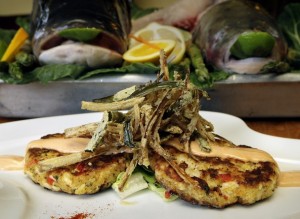by Robert Hirschfeld, Coalition Organizer – Invasive Species
In the three weeks since the Illinois Department of Natural Resources announced its plan to fight hunger and Asian carp in one fell swoop, my Asian carp twitter feed has seen more action than in the previous two months combined. #AsianCarp is trending, largely due to the initial disgust* that greets a suggestion of eating river monsters.

(I’ve yet to collect the full set of relevant data on what percentage of those adamantly refusing to eat carp don’t think twice about hot dogs. Didn’t your parents ever tell you, “Don’t knock it ‘til you try it”?)
Chicago Tribune columnist Dennis Byrne gets it right when he describes lobsters as “the 19th century equivalent of bigheads.” It has also been said that lobsters are the cockroaches of the sea, and yet it’s a sign of refinement and taste to drop a few bills to rip open their exoskeletons and devour the tasty innards. The superior marketing wizards of the Northeast knew that demand is created from the top down, so you sell it as a delicacy, not some kind of “soylent marine” to be pushed on the masses.
Of course, Mr. Byrne’s ultimate answer is to throw up his arms in disgust at the likely series of unintended consequences that would follow from creating a market for Asian carp. While I take issue with cynicism as the basis for (a lack of) public policy (even in Illinois!), Mr. Byrne is right to be thinking about the logical extension of marketing an invasive species as food.
While humans have driven some species to extinction or endangerment, we have also propped up populations of others to artificially high levels—see chickens, pigs, and cows. Once a profitable industry is established, all the incentives are in place to continue the existence of that industry, even if it trades in a troublesome product. Even if the original purpose of the industry was to exterminate the product. Who will want to end a profitable business—especially in this economy?
Personally, I don’t care if Asian carp are eaten or made into fertilizer for your garden. I’m happy to see them pulled out of the rivers they currently infest, and I’m thrilled to decrease the pressure on the experimental electric “barrier” which is currently serving as the last line of defense against a full-scale Asian carp invasion in the Great Lakes.
Still, Illinois needs to think carefully about its approach on this issue. If the state can successfully sell Asian carp as a healthy, protein-rich, and delicious food, then it should do so. But it should not forget that this is a means to an end—removing the threat of Asian carp.
Which brings me to the deeply buried lead. Asian carp represents only the most visible invasive species threatening our rivers and lakes. The US Army Corps of Engineers has identified 39 (yes 39!) high-risk invasive species poised to use the Chicago Waterway System to infest the Great Lakes and Mississippi River basins. You can eat all the carp you want (and as they are delicious, I encourage you to do so), but that will not end the threat of invasive species. A real solution can only take the shape of a permanent, physical barrier separating the Great Lakes and Mississippi River watersheds.

As for the dozens of other invasive species, they’re unlikely to have a place at the table. I assure you, no one is going to want to eat Viral Hemorrhagic Septicemia. And unlike the initial aversion to carp, that is a very rational response.
* The reaction to Asian carp appears to be based on association with the “trash fish” Common carp. Unlike Common carp, Asian carp feed on plankton from the middle of the water column, making them a cleaner-tasting fish and keeping them low in toxins like mercury that can bioaccumulate in fish like tuna.







